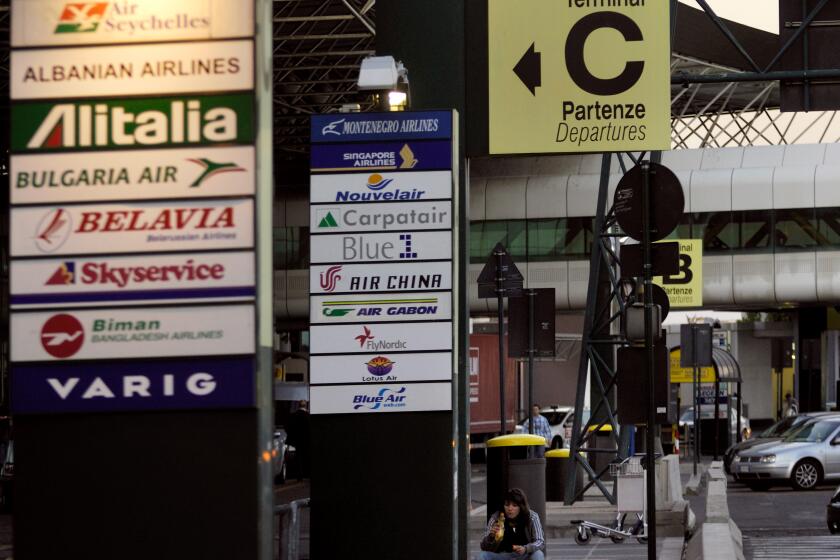Opinion: Flying while disabled is a nightmare. It shouldn’t be this way

I live in Boston and want to visit my daughter in Los Angeles. Easy, right? Book a flight, visit daughter, fly home. If only. I use a power wheelchair that costs about as much as a small SUV. I’m terrified it could be damaged by an airline. My chair, a Quantum Edge, is essential to my getting around. To having a life.
The Quantum and I met two years ago and have been inseparable ever since. I didn’t see it coming, our relationship. It never occurred to me that I could develop a crippling illness that would eventually require use of a 400-pound mobility device — but I digress.
Back to visiting my daughter. Or, rather, not visiting. To fly to L.A., I must relinquish the Quantum and pray it won’t be in pieces when I land. Airlines mishandle thousands of power wheelchairs each year, according to data from the Department of Transportation. More than one in every 100 wheelchairs and scooters transported in the cargo hold are damaged, delayed or lost.
Airlines use behavioral economics, which combines psychology with traditional economics, to exploit biases that drive us to pay more than necessary.
Some wheelchairs are so mangled they pose a safety risk for users or are rendered inoperable. Imagine handing over your prescription eyeglasses and squinting anxiously the whole flight only to have them returned with cracked lenses and a broken frame.
It gets worse. To visit my daughter, I have to give up bodily autonomy. Risk being treated like a side of ham. Airline personnel — strangers with vague and questionable training — will lift me out of the Quantum and transfer me into the “aisle chair,” a diminutive wheelchair used for boarding and deplaning. Once aboard the aircraft, they will push me down the aisle, stop at my row and transfer me into my cabin seat. Fellow passengers may or may not be looking on. Upon landing, I get to do it all again, in reverse. And, yes, disabled travelers have been dropped or critically injured when improperly transferred.
The fun doesn’t stop there. Wide-body jets are required to have an accessible bathroom, but a wheelchair user can’t get to the bathroom without returning to the dinky aisle chair to be pushed to the loo by a crew member. Single-aisle flights currently lack accessible bathrooms and so disabled passengers dehydrate themselves or wear adult diapers. I was blissfully unaware of all this when I could walk.
U.S. aviation doesn’t have enough pilots, mechanics and air traffic controllers. Could it be because the industry is too “male, pale and stale”?
Let’s say I muster the courage to fly. If my wheelchair is badly damaged, the airline is on the hook for the cost of repair or replacement. But it could take weeks or months before I have a mobility device in working order. A loaner chair might work, but not if you need a custom chair. You may miss work or school, even have to stay in bed. That’s a lot to dwell on at 30,000 feet.
Solutions exist. At a minimum, airlines could be required to use universal storage cases to protect power wheelchairs and mobility scooters, or tie-down straps to secure these expensive devices in the cargo hold. But what would really make me feel included would be to stay in my own chair, to roll down the jetway and on to the aircraft, lock down in the cabin and relax.
How is it that so little effort has been spent to ensure people like me feel welcome and comfortable when flying? Trains and buses are accessible — why not airplanes? Turns out the Americans With Disabilities Act does not apply to aircraft — which explains why I can roll into public buildings but not on to a jet. What governs the skies is the lesser-known and comparatively toothless Air Carrier Access Act of 1986. The ACAA prohibits discrimination of passengers with disabilities — I can’t be denied a seat on a plane — but that’s about where the protection ends. The standards for accessibility features on aircraft are so appallingly inadequate, it’s like a cruel joke.
It used to be the word ‘so’ never caused problems, never bothered anyone. It was the working man’s ‘therefore.’ Now it’s gone phony, insincere, so-so.
I’m trying to be optimistic. Earlier this year, the DOT identified as a goal enabling passengers to stay in their personal wheelchairs on aircraft, and the Federal Aviation Administration initiated a “research roadmap” to study feasibility. Near-term improvements include training requirements to better assist disabled passengers and properly stow their mobility devices.
In June, Delta Air Lines unveiled a prototype for a standard airline seat that converts into a secure docking station for power wheelchairs when needed. Talk about a game-changer! I’m telling you, airlines, if you build it, we will come.
In the meantime, I’ll be here in Boston waiting for my daughter’s plane to land but dreaming of spending Christmas with her in L.A. I see it now: The Quantum and I, bedecked in tinsel, roll off the jetway, neither of us the worse for wear.
Suzanne Costas is a licensed independent clinical social worker in Boston. In 2008, she was diagnosed with inclusion body myositis. Over the course of 15 years she went from using a cane, to a walker and, finally, a power wheelchair in 2021.
A cure for the common opinion
Get thought-provoking perspectives with our weekly newsletter.
You may occasionally receive promotional content from the Los Angeles Times.






